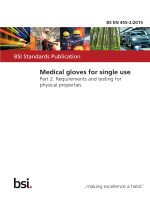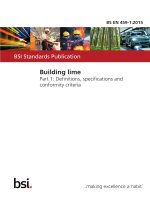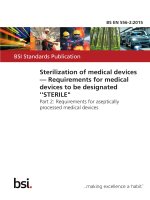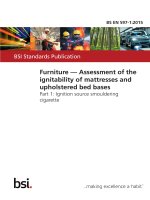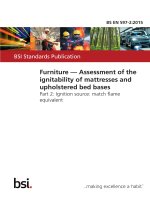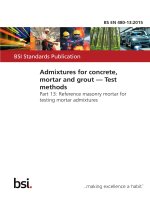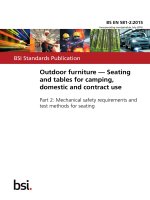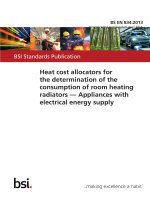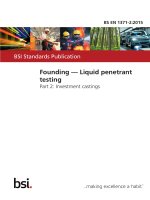Bsi bs en 61970 452 2015
Bạn đang xem bản rút gọn của tài liệu. Xem và tải ngay bản đầy đủ của tài liệu tại đây (20.52 MB, 106 trang )
BSI Standards Publication
Energy management system
application program interface
(EMS-API)
Part 452: CIM model exchange specification
®
bsL
..making excellence a habit:
BS EN 61970-452:2015
BRITISH STANDARD
National foreword
This British Standard is the UK implementation of EN 61970-452:2015. It
is identical to IEC 61970-452:2015. It supersedes BS EN 61970-452:2013
which is withdrawn.
The UK participation in its preparation was entrusted to Technical
Committee PEL/57, Power systems management and associated
information exchange.
A list of organizations represented on this committee can be obtained on
request to its secretary.
This publication does not purport to include all the necessary provisions of
a contract. Users are responsible for its correct application.
© The British Standards Institution 2015.
Published by BSI Standards Limited 2015
ISBN 978 0 580 87383 6
ICS 33.200
Compliance with a British Standard cannot confer immunity from
legal obligations.
This British Standard was published under the authority of the
Standards Policy and Strategy Committee on 30 June 2015.
Amendments/corrigenda issued since publication
Date
Text affected
EUROPEAN STANDARD
EN 61970-452
NORME EUROPEENNE
EUROPAISCHE NORM
May 2015
ICS 33.200
Supersedes
EN 61970-452:2013
English Version
Energy management system application program interface
(EMS-API) - Part 452: CIM model exchange specification
(IEC 61970-452:2015)
Interface de programmation d'application pour systeme de
gestion d'énergie (EMS-API) - Partie 452 : spécification
d'échange de modele CIM
(IEC 61970-452:2015)
Schnittstelle fur Anwendungsprogramme fur
Netzfuhrungssysteme (EMS-API) - Teil 452: CIM
Austauschformat Spezifikation
(IEC 61970-452:2015)
This European Standard was approved by CENELEC on 2015-05-14. CENELEC members are bound to comply with the CEN/CENELEC
Internal Regulations which stipulate the conditions for giving this European Standard the status of a national standard without any alteration.
Up-to-date lists and bibliographical references concerning such national standards may be obtained on application to the CEN-CENELEC
Management Centre or to any CENELEC member.
This European Standard exists in three official versions (English, French, German). A version in any other language made by translation
under the responsibility of a CENELEC member into its own language and notified to the CEN-CENELEC Management Centre has the
same status as the official versions.
CENELEC members are the national electrotechnical committees of Austria, Belgium, Bulgaria, Croatia, Cyprus, the Czech Republic,
Denmark, Estonia, Finland, Former Yugoslav Republic of Macedonia, France, Germany, Greece, Hungary, Iceland, Ireland, Italy, Latvia,
Lithuania, Luxembourg, Malta, the Netherlands, Norway, Poland, Portugal, Romania, Slovakia, Slovenia, Spain, Sweden, Switzerland,
Turkey and the United Kingdom.
CENELEC
European Committee for Electrotechnical Standardization
Comité Européen de Normalisation Electrotechnique
Europaisches Komitee fiir Elektrotechnische Normung
CEN-CENELEC
© 2015 CENELEC
Management Centre: Avenue Marnix 17,
B-1000 Brussels
All rights of exploitation in any form and by any means reserved worldwide for CENELEC Members.
Ref. No. EN 61970-452:2015 E
BS EN 61970-452:2015
EN 61970-452:2015
Foreword
The text of document 57/1451/CDV, future edition 2 of IEC 61970-452, prepared by IEC/TC 57 "Power
systems management and associated information exchange" was submitted to the IEC-CENELEC
parallel vote and approved by CENELEC as EN 61970-452:2015.
The following dates are fixed:
e
e
latest date by which the document has to be implemented at
(dop)
2016-02-14
latest date by which the national standards conflicting with
the document have to be withdrawn
(dow)
2018-05-14
national level by publication of an identical national
standard or by endorsement
This document supersedes EN 61970-452:2013.
Attention is drawn to the possibility that some of the elements of this document may be the subject of
patent rights. CENELEC [and/or CEN] shall not be held responsible for identifying any or all such
patent rights.
Endorsement
notice
The text of the International Standard IEC 61970-452:2015
European Standard without any modification.
was
approved
by
CENELEC
In the official version, for Bibliography, the following notes have to be added for the standards indicated:
IEC 61970-1
NOTE
Harmonized as EN 61970-1.
IEC TS 61970-2
NOTE
Harmonized as CLC/TS
IEC 61970-552
NOTE
Harmonized as EN 61970-552.
61970-2.
as
a
BS EN 61970-452:2015
EN 61970-452:2015
Annex ZA
(normative)
Normative references to international publications
with their corresponding European publications
The following documents, in whole or in part, are normatively referenced in this document and are
indispensable for its application. For dated references, only the edition cited applies. For undated
references, the latest edition of the referenced document (including any amendments) applies.
NOTE 1
When an International
the relevant EN/HD applies.
NOTE 2
Up-to-date information
available here: www.cenelec.eu.
Publication
on
the
has been
modified
latest versions
of the
by common
European
modifications,
Standards
indicated by (mod),
listed
in this
annex
Publication
Year
Title
EN/HD
Year
IEC 61970-301
2013
Energy management system application
program interface (EMS-API) Part 301: Common information model
(CIM) base
EN 61970-301
2014
IEC 61970-501
-
Energy management system application
program interface (EMS-API) Part 501: Common Information Model
Resource Description Framework (CIM
RDF) schema
EN 61970-501
-
is
BS EN 61970-452:2015
-~2-
IEC 61970-452:2015@ IEC 20145
CONTENTS
890013229218...
ID
. ..
.....a...aa (444A...
ESE EUG FESO ES SEE Satu ESE EEE EE OS 6
N 4019/9 019019) mm..(ú.
ẤM...
.
4...
...a
1
SCOP
ccc
2
Normative
r@fGrences ooo =...........ŨỒẦẢẢ.......
TS...
s6
9
cece ccc cence ne cee eee nee nee keen nee e nee eG banc rene d ed ee eG reared ee easter ener eden ee teeeseeeneeeeeeneeenes 10
c6 `...)
he
S............
mm...
11
11
3.1
®@.-
...
.. .
.
-(.....
11
3.2
€1-10-/-18/-910)11-141-)vì:-aaaaadđidđiaiiẳẳẳiẳäắáa.
ằ.‹4
11
3.3
HT
12
3/90901- 3810199 .-111:eiidiẳaaaaẳẳẳaa]Â)ÂHẦẬHĂ)..
3.4
8e 2112ix210i21si1:i-- AE
3.5
e2). 1100/2144
=-‹.
..
ằẼ.Ẽ.. ..
13
20))086i-:.--ãadd:'đáđáaẳẳ.
14
3.5.4
6ï...
HH.
äằäằẼŠ
14
3.5.2
I0 mì
15
82.
3.6
Voltage or aCVE
3.7
USO OF CUIVES
3.7.1
3./.2
n6 “6=
ca.
DOWeF T8QUÌđLOR oo...
Generating
ằ...
cece cece ceca eect ee een ee ceeeee esse enensaenenenes 15
........
6.0.1 81.
3.8
1n
a4...
15
.a..........ă..Ặ...
unit reactive power [MMS occ
cc ces eee sees ee eeeereen eset en ene ens 15
Definition Of SCHEGUIES (a4...
.
851/0
8°
15
ha
an...
cece ccc
G....
na
a4...
nh eS 16
EE een HE Ea ES 16
4.1
0100 15)1019)(-)) 0n (vi)
- -l/¿ăšỉaiaiiiiiidaiiiitii....
18
4.2
8 12‹e(.-891.-:'---diiiiẳảảảảỶẳỶaảắẢẢẢẢ...
18
4.2.1
ACCUMUIALON
...
.......
16
4.2.2
[X29 2010/ -iis)-17
4.2.3
ACLINGSEGMENE.
0N
17
4.2.4
ACTIVEPOWErLIME XS...
ed14
4.2.5
1:1
4.2.6
[1211x211
4.2.7
[ai 020inás) c0)
4.2.8
ST: oRtAO]
ENC |S |
4.2.9
BAY
4.2.10
s14
4.2.14
>0ai
4.2.12
012132038: an...
22
4.2.13
0e11»iáii18v
22
4.2.14
ConformLoadSchedule
4.2.15
Ø0
4.2.16
TOT
TK) Nat:
4.2.17
ControlAreaGeneratingunit.
=a-Ả..........
n
ad...
d4...
4...
1...
.
.
.....d...
17
19
ba EE EEE EERE EES 19
a...
20
|RA-::daiiiái....
... .Ẽ Ẽ_....
20
cee 20
ccc cece ec ee cece eee e ene e nee e eee SEA EO EA DE E;G EASE SHEE SEAS; EG SESGE Ea DEO E DEE OG EG EEE SE EEG Gabe REN EEE S 21
<4.
.... . .
0
tee eb ee seca seca ee ee teed te seneeeeeeaensneaentnenteeens 21
.
.
šI€0s Ta...
21011100)1e
000
TA
ẼằẼŠẼ
a.-.a.
21
ccc cece ccc e ese e cena een e cease cents nease ease eenenenenes 23
¬.
Đa...
.Ẽ.Ẽ.. . .
23
24
cc cccc scene ee eee reese ee neaeeeeaeaene estan enon seaeneen ees 24
4.2.18
CUPPONtLEMi
4.2.19
(017127, —]RT-):-adiididiiiiiiiiaiaiäẳäắäẳä.....
cece cence reece ene ee ee ee cannes nee eres cree ne eed ed er seen ee nen en eneneseeeenenenes 25
25
4.2.20
m8...
—-......
28
4.2.21
IMEesein cai...
(4...
28
4.2.22
Ms
28
4.2.23
ME1oro:-:1-—..
ccc .. .
. ... .
...
....
27
4.2.24
s19
27
4.2.25
s0 72115111 sim...
4.2.26
2110812420272
Ta...
095104110010)
An
((a.....
. .. ..
...
ÖÖÖŒ(....
28
7210...
ene red treet ee ee ea sees ee esneestneseneneeseaens 29
BS EN 61970-452:2015
IEC 61970-452:2015 @ IEC 2014
~3-
4.2.27
E QuivalentNetwork 00. e.........aa...
30
4.2.28
EQUIVAIGNTSIUNE 000. -‹ddddăăă.......
30
4.2.29
ekOk S11] aks |=) TA...
30
4.2.30
£@1-ã1271i99
51
4.2.31
GEOGraphiCalRe
gion
<<.
33
4.2.32
€Ìi9)--SNs))
| 1/210) -i8ie)..-ii0i))i..-laiiddidiiiiiiỶỶ..
33
4.2.33
ah¿99€-00-1/-000/9191 0a
ăäằ.ằ.
4.2.34
là 4$Ì19141121) giiiiaaddiẳiẳiẳẳd.......
Seed EE EE EEE EEG EEE EES 34
4.2.35
FECETSTOCIMVEFSION
4.2.36
LEV
0...
2.
...
ooo
...ÔỒằÔằẨằa
eee sea ba etree tienes 34
———ằằ
ằ a.. . .
(..
Noo l0
4.2.38
LOAD Break SWHCH
4.2.39
LoadResponseCharacteristic oo.
oo
xa...
a4...
ccc ccc ee nc es een see ee ee see eee en sees nh
4.2.42
NAME
4.2.43
In...
4.2.46
35
ca
36
và nh nhà sa 36
<< 111ã-141-310/-111
4.2.45
35
An a4...
4.2.44
4.2.44
31
ccc ccc ee cee ee ee cee et eee ee eed eenea sd eeereeseeeneeeeeegeaen
ees eaeenes 35
4.2.37
4.2.40
.....
0.
cece cece
——
(ú....
——ằ¬ằ
2021) 3008
38
Eo SHE ba EE: 38
ằe
39
ce
40
a......Ỷä.
Ea et eEE EES: 40
NONCONfOrMLOadGrou
00.
ccc cc cecec ee cee ee ene ec eeeeeeen ease een eeeeeeeneatentneaeeenenass 41
| »)2001214)1/3)0)2)83:-is12iviìi-1s000ï-Ê ataadiiiaẳảẳảẢẢ..
.
41
4.2.47
NuclearGeneratingunit 0c
4.2.48
0095-02
4.2.49
@05 21:1 sai118ið 082...
4.2.50
PhaseTapChangerAsvinelETl
CB. .c
4.2.54
8221-18-60
4.2.52
PhaseTapChangerSymetrical
4.2.53
2-50-9600)
0/3) d1-0/:-
4.2.54
PhaseTapChangerlTabularPaint oo...
4.2.55
IãS) 4108 N»>141-1191ã141>aidaiiiiiaaảẢ...
48
4.2.56
PowerTransformerE
nd nh
48
4.2.57
s50...
...
4.2.58
N9
4.2.59
RatioTapChangerTabularO
TL
4.2.60
š-2i9400/-02127/-1000101/011 2-1-1...
esate ta euseneenenss 52
4.2.64
Regular Time@Paint 000
4.2.62
E900
100090
4.2.63
E900
10922
4.2.64
SEASON
4.2.65
SEPICSTCOMPSNSALOL
4.2.66
S310101091619-0) 2=...
4.2.67
Si
4.2.68
Sen
4.2.69
SUDGSCOGrAPNICAIREGION
4.2.79
Cie] 0] elle) 0k:
4.2.71
SUDSTALION occ
4.2.72
S012...
(c(đ...
60
4.2.73
S)/1J(9)°21901-1310))IaiiiiiiiiiaẳiẳiiŸỶẳỶẳ44...
60
101i
ccccccc cece ce see es eee eeeed ease en seneeeeneatetneaeeeenenass 42
8...
0000:
0n
00/00/1501)
áắằrằrằaằẰR.
42
—....ằằắẮa.
43
cc ce nh sn ket nh kh kh TH TT
hà kh kh hài 43
<=a..... a4...
oo.
44
ccccccc ne cce nee eee seen eeu ee renee eee sea basset en eenes 45
nnáẢẢẢ...
=a.......
8n.
46
cccccnceec eee see eneeeee esse neeeneeeraeseeneeeeies 46
.-uẢẢẢ.
.aăa.(.
1
.
50
caeuceeeenees 51
cec ces ee aca ee eee eu nee ee esate tatu cence eres 51
cece eee eee ener
adadg
la
..
53
cơn đưị4.ššaaa..
esneaseeegeaenenn eas: 54
na
e—....
`
«
0:0091x)i1e 2
55
AEE Sen ee EN GEG SE EE EAD CASA EG See SESE DEA EEG ED EG Ser ee EA ADEE EEE EEE 56
.
a../ (a4
56
56
nh...
ee cere eer ee teeta eta te etd ee bred et eta ee ne ae 57
đa...
a
58
...ẰẼaaa...
--.
...
.ỤŨ.
4.2.74
S019011919110
1) s31.
4.2.75
H96
0i
An
59
59
ccc e cece e eee e een e SEED PHAGES REESE EEG EE SHG ES Een SH EGG EASE EEG EH eS Eeenen SE EEE ES 59
“(ca
0n...
.
ằẰ
..
e 61
..
63
BS EN 61970-452:2015
IEC 61970-452:2015 @ IEC 2015
—~4—
4.2.76
TapScnedule
4.2.77
`:
4.2.78
ThermalGeneratingUniẨ................ccccccccv.c
4.2.79
TIS FLOW.
4.2.80
Volflagelevel oo.
4.2.84
Voltage LINH
4.2.82
WindGeneratingUnit
4.3
cuc cuc nh nh nh
reo
8=
ee eteveeeeeaseevetenees
cece cscceccen cess eee reeeeeeneeereeneees
ccc cece eens enna eee
ch
Abstract Classes oo...
xa
o.oo
--(A
4.3.4
Basiclnterval5Schedule.............................
4.3.2
âonductingEquipbmenif.........
eee
4.3.3
CONGUCEOP ai...
4.3.4
ConnectivityNodeContainer.....................
4.3.5
01a...
4.3.6
s2-iv
2 -:Đnd......
4.3.7
s00
1= 2011
4.3.8
EquipmentContainer oo...
4.3.9
EquivalentE quipment oo...
cece eee
4.3.10
IdentifiedObject ooo. đa.
4.3.11
Re. -oC sa...
4.3.12
IS 190-0010 r(íÁa.
teense ene ens
co cuche
4.3.13
MeasuremenfValU
4.3.14
09-10-1000 11010
che
4.3.15
PhaseTapChange6r..............................c.c..
4.3.16
PhaseTapChangerNonLinear...................
4.3.47
PowerSystem Resource...
4.3.18
RegularintervalSchedule.....
4.3.19
RegulatingCondEg.
4.3.20
XotatingMachine.....................
cuc cuc cv.
l/ÄPGríaDaaa...
eee
coi cào
4.3.21
SeasonDayTypeSchedule........................
4.3.22
TAPCHAngQer...
4.3.23
TransformTE
NĨ
4.4
0. cccccceceeceeu
cen se essen een ens
uc
nh nh khe
21121271192 11...
4.4.1
ControlAreaTypelKind.......................ccccc.e.
44.2
CURVE STYLE ad.
4.4.3
71-80...
4.4.4
GeneratorContralSourceé oo.
4.4.5
GOperatioenailLmitDirecttonKind..................
4.4.6
RegulatingControlModekind....................
4.4.7
6S
4.4.8
SVCGControlMOdS s2...
cuc chà.
4.4.9
SynchronousMachineOperatingMode
s0
eee
in...
4.4.19
SynchronousMachineType.......................
4.4.41
TapChangerkind....
4.4.12
TransformerCGontrolMode.........................
ccc cece ees eee sees
4.4.13
0010650001120...
4.4.14
VindingConnecClODD.
4.5
4.5.1
4.5.2
DATALY DES oo
la)
0v
cuc cà.
ccc ccc ccc ence ee ee scene censeeeteeeeeass
In...
AngleDegrees dd...
BS EN 61970-452:2015
[IEC 61970-452:2015@ IEC 2015
4.5.3
e3ảv
4.5.4
CONGUCTANCE
4.5.5
0170/01, 1...
4.5.6
N5
4.5.7
A Ce a
4.5.8
PO
0n
-................
4.5.9
RATS
COL 10 [01
4.5.10
X0
4.5.14
RCS
FoR 18 Os
4.5.12
CTL 010) 6 |
aaa.
...............
..........
(dd...
cece
GP Q00
00g nh TH
ng TT KH HH
TT REEF US atu EE EOE ned Eo cate cence Gea babe tenes
ec
ces
2822...
Š ẽa...
cece
ce
4.5.13
SUSCEPLANCE
4.5.14
2516 |
4.5.15
ValtagePerReacive
Power ỤỢ............ nh
Amphfications
Or
-~5=—
ẰẮằ5—a.. .
-(((.ccaaảaa441
cer
And CONVENTIONS 2.00.
5.1
@ 02
5.2
b0
5.3
N23
5.4
Roles and multiplicity
ccc cece ence eee teense eb
d4...
EES
đe
1:
=4...
....ằằeằằ«Ắa..
2026
š
0:3
Annex A (informative)
Model
Annex
Modeling
B (informative)
Tô... (ad.
SB....(.4.{d131đLGaa11S ae...
exchange
US6 CASS
oo...
authorities o0000
c ccc cece ee ee ce ee ceee tees sees enenenenenes
ccc cece cee ene ee tected eee ce tuna teen eens
Annex C (informative) Common power system model (CPSM) minimum data
021142) 8...
“đả...
5149191501-161) TP
Figure
ccc
1 — Two wmding
transforrmner Inp©d@nC© ........
Figure 2 — Three winding transformer IMp@d ance...
Figure A.1 — Security COOrdiINators
Figure A.2 — CIM
model
Figure A.3 — Revised
0.0
Figure A.4 ~ Hierarchical
model
cece ce ne eee ecene este eaeeenenenenen en
aáaa4a
cee e cence eee een e ence e ened Eade ree tenet et dee etn t nee:
exchange... ccccccccccceneneeeeeeen
ener sense seeeeeatetneaseeveness
Modeling
Table
1 — Valid M@asureMentTyPes
Table
2 — Profiles
Table
3 — Valid
defined
cece
cence eee eee
exChanQ© su...
CIM
ccc cece cece reece eee eens ee eee denen en en seen as
Q.0
ooo.
in this Gocument
attribute Values ooo
c ccc e ccc e etna ee eee e aces eee bce bs ea be ed ea eu cated Heer EEE
TH ng nh HT TH TT cọ ni km
oo.
cv
nh nha
ccc cccccceucesuceseeesennseuauregteenenrsnntennrens
ccc ence ence cr eneeueneveretuaueesuensaeteunevenevenseenunernunevereres
BS EN 61970-452:2015
IEC 61970-452:2015@ IEC 2015
— 6~
INTERNATIONAL
ELECTROTECHNICAL
COMMISSION
ENERGY MANAGEMENT SYSTEM APPLICATION
PROGRAM INTERFACE (EMS-API) Part 452: CIM model
exchange
specification
FOREWORD
1)
The International Electrotechnical Commission (IEC) is a worldwide organization for standardization comprising
all national
electrotechnical
committees
GEC
National
Committees).
The
object of IEC
is to promote
international co-cperation on ail questions concerning standardization in the electrical and electronic fields. To
this end and in addition te other activities, 1/EC publishes International Standards, Technical Specifications,
Technical
Reports,
Publicly Available
Specifications
(PAS)
and
Guides
(hereafter referred
to as “IEG
Publication({s)”). Their preparation is entrusted to technical committees; any IEC National Committee interested
in the subject dealt with may participate in this preparatory work.
International, governmental
and nongovernmental organizations liaising with the [EC also participate in this preparation. IEC collaborates closely
with
the
agreement
The formal
consensus
International
between
Organization
for
the two organizations.
Standardization
(SO)
in accordance
with
decisions or agreements of 1EC on technical matters express, as nearly
of opinion on the relevant subjects since each technical committee
conditions
determined
by
as possible, an international
has representation from all
interested IEC National Committees.
IEC Fublications have the form of recommendations for international use and are accepted by IEC Natonal
Committees in that sense. While all reasonable efforis are made to ensure that the technical content of [EC
Publications is accurate, [EC cannot be held responsible for the way in which they are used or for any
misinterpretation by any end user.
4)
in order to promote international uniformity, IEC National Committees undertake to apply [EC Publications
transparently to the maximum
extent possible in their national and regional publications. Any divergence
between any IEC Publication and the corresponding national or regional publication shall be clearly indicated in
the latter.
iEC itself does not provide any attestation of conformity.
assessment services and, in some areas, access to JEC
services carried out by independent certification bodies.
Independent certification
marks of conformity. IEC
§)
?)
All users
8)
Attention is drawn to the Normative references cited in this
indispensable for the correct application of this gublication.
9)
Attention is drawn to the possibility that some of the elements of this [EC
patent rights. IEC shall not be held responsible for identifying any or all such
should
ensure
that they have
the latest edition
bodies provide conformity
is not responsible for any
of this publication.
No liability shall attach io [EC or its directors, employees, servants or
members of its technical committees and [EC National Committees for
other damage of any nature whatsoever, whether direct or indirect,
expenses arising out of the publication, use of, or reliance upon,
Publications.
agents including individual experts and
any personal injury, property damage or
or for costs (including fegal fees} and
this [EC Publication or any other [EC
publication.
Use
of the
referenced
Publication may
patent rights.
be
publications
is
the
of
The present part of International Standard IEC 61970 has been prepared by IEC
committee 57: Power systems management and associated information exchange.
This second edition cancels and
constitutes a technical revision.
replaces
This edition
edition:
significant technical
includes
the following
the
first
edition
published
changes
a)
subclause 3.3, Transformer modeling — Updated description
reflect changes in the modelling of transformers to work
distribution systems;
6b)
subciause 3.5.1, Use of measurement
the measurement model:
classes
— General
with
in
2013.
respect
subject
technical
This
to the
edition
previous
of transformer modelling to
for both transmission and
— Updated
to reflect changes
to
BS EN 61970-452:2015
[IEC 61970-452:2015@ IEC 2015
~~
©)
subclause 3.5.2, ICCP data exchange — Updated io reflect changes
identification in the model (IdentifiedObject, Name, and NameType):
3)
the following detailed changes
®
were made
Added Measurement.unitMultiplier and
association to class Unit.
Added
PowerTransformerEnd
to Clause 4, CIM
Equipment
Measurement.unitSymbal
to
the
use
of
Profile:
to replace
to replace TransformerWinding.
Made PhaseTapChanger not concrete (abstract) and added
PhaseTapChangerNonLinear (also not concrete), PhaseTapChangerSymetricai,
PhaseTapChangerAsymetrical, and PhaseTapChangerLinear.
Added PhaseTapChanger.TransformerEnd
PhaseTapChanger. TransformerVVmding.
Added RatioTapChanger.TransformerEnd
RatiolapChanger. TransformerWinding.
Added
TapChangerControil
to replace
to replace
class to replace direct link TapChanger.RegulatingControl.
Added RatioTapChanger.stepVoltageincrement to replace
TapChanger.stepVoltageincrement.
Added PhaseTapChangerTabular, PhaseTapChangerTabularPoint,
RatioTapChangerTabular, and RatioTapChangerTabularPoint to replace
impedanceVariationCurve, PhaseVariationCurve, and RatioVariationCurve.
Added
Switch.ratedCurrent as optional attribute.
Changed all attributes of LoadResponseCharacteristic to optional except for
exponentModel.
Changed
Added
CurveData.y2Value
to optional.
PowerTransformer.vectorGroup
as optional attribute.
Added note to OperationalLimitSet stating that “Either an association
an association to Terminal must be supplied, but not both.”
Added
SeriesCompensator.r0
Added
RotatingMachine
to
the
profile
so
SynchronousMachine as an optional attribute.
Made
Added
association
between
OperationalLimitType
classes
Removed
Added
Name
and
or
and x0 as optional attributes.
Added attributes for PhaseTapChangerTabularPoinit
RatioTapChangerTabularPoint.
Changed
optional.
to Equipment
and
that
RegulatingCondEq
ratedS
and
can
be
RegulatingControl
attributes direction and acceptableDuration
NameType
inherited
by
to
be
optional.
to profile.
PowerTransformer.vectorGroup from the profile.
PowerTransformerEnd. phaseAngleClock
as an optional attribute.
Made attributes ReguiatingConirol. targetRange and targetValue optional and
note stating that they are not required if a RegulationSchedule is provided.
added
a
Added TransformerEnd.endNumber to the profile for use with
PowerTransformerEnd.phaseAngleClock.
Added
association
OperationalLimt.OperationalLimitSet.
Added
association
Name.identifiedObject.
Updated
PowerTransformer
profile description to also refer to Terminals.
Changed
reference
io association
RegulatingControl. RegulationSchedule
RegulationSchedule.RegulatingContral instead.
to
use
BS EN 61970-452:2015
IEC 61970-452:2015© IEC 2015
—8—
e
Changed TapChanger attributes highStep, lowStep, neutralStep
optional, because they are not required if the ItcFlag is false.
e
Changed BasiclntervalSchedule.value2Unit
because
they
are
not
required
for
SwitchSchedule.
e
Changed Analog.positiveFlowin
direction (voltage, for instance).
e
Added
PowerTransformerEnd.g
e
Added
SynchronousMachine.referencePriority
e
Added
profile description for AccumulatorValue,
explaining that the classes are only used to define
not to supply values for those measurements.
e
Added
attribute Switch.retained
e
Added
association TransformerEnd.BaseVoltage
e
Made
association
The text of this standard
to
be
normalStep
because
not
all analogs
have
a flow
as optional attribute.
as optional attribute.
AnalogValue,
measurements
and
DiscreteValue
available via ICCP,
as required.
as optional.
optional.
on the following documents:
CDV
Report on voting
57/1451/CDV
57/1503/RVC
Full information
voting indicated
on the voting for the approval
in the above table.
This publication
has been drafted
of this standard
can
in accordance with the ISO/IEC
be found
Directives,
in the report on
Part 2.
A list of all parts in the IEC 61970
series,
published
under the general
management system application program interface (EMS-API), can be found
website.
title Energy
on the IEC
The committee has decided that the contents of this publication will remain unchanged
the stability date indicated on the IEC web site under "“" in the
related to the specific publication. At this date, the publication will be
*
reconfirmed,
ồ
withdrawn,
*
replaced
*
amended.
to
and RegularTimePoint.value2 to optional,
RegulationSchedule,
TapSchedule
or
optional,
ControlArea.energyArea
is based
and
until
data
by a revised edition, or
A bilingual version of this publication
IMPORTANT — The
that
it contains
understanding
colour printer.
may
be issued at a later date.
‘colour inside’ logo on the cover
colours
which
are
considered
of its contents.
Users
should
page of this publication indicates
to
be
useful
for the
correct
therefore
print this
document
using
a
BS EN 61970-452:2015
[IEC 61970-452:2015@ IEC 2015
—9~
INTRODUCTION
This standard is one of the IEC 61970
(API) for an energy management system
series that
(EMS).
define
an
application
program
interface
The IEC 61970-3x series of documents specify a Common Information Model (CIM). The CIM
is an abstract model that represents all of the major objects in an electric utility enterprise
typically needed to model the operational aspects of a utility. It provides the semantics for the
IEC 61970 APIs specified in the IEC 61970-4x series of Component Interface Standards
(CiS). The IEC 61970-3x series includes IEC 61970-301, Common Information Model (CIM)
base and
draft standard
IEC 61970-302,
Common
Information
Model (CIM)
Financial,
EnergyScheduling and Reservations.
This standard is one of the IEC 61970-4x series of Compoment Interface Standards that
specify the functional requirements for interfaces that a component (or application) shail
implement to exchange information with other components (or applications) and/or to access
publicly available data in a standard way. The component interfaces describe the specific
message contents and services that can be used by applications for this purpose. The
implementation of these messages in a particular technology is described in IEC 61970-5.
This part of IEC 61970 specifies the specific profiles (or subsets) of the CIM for exchange of
static
power
system
data
between
utilities,
security
coordinators
and
other
entities
participating in a interconnected power system, such that all parties have access to the
modeling of their neighbor’s systems that is necessary to execute state estimation or power
flow applications. Currently only one profile, the Equipment Profile, has been defined. A
companion standard, |EC 61970-552, defines the CIM XML Model Exchange Format based on
the
Resource
Description
Framework
(RDF)
Schema
specification
language
which
is
recommended to be used to transfer power system model data for the IEC 61970-452 profile.
BS EN 61970-452:2015
IEC 61970-452:2015
@ IEC 2015
— 10—-
ENERGY MANAGEMENT SYSTEM APPLICATION
PROGRAM INTERFACE (EMS-API} —
Part 452: CIM model
1
exchange
specification
Scope
This part of IEC 61970 is a member of the IEC 61970-450 to -499 series that, taken as a
whole, defines at an abstract level the content and exchange mechanisms used for data
transmitted between control centers and/or control center components.
The purpose of this document ts to rigorously define the subset of classes, class attributes,
and roles from the CIM necessary to execute state estimation and power flow applications.
The North American
Electric Reliability Council (NERC)
Data Exchange Werking Group
(DEWG)
Common
Power System
Modeling
group
(CPSM)
produced
the original data
requirements, which are shown in Annex C. These requirements are based on prior industry
practices for exchanging power system model daia for use primarily in planning studies.
However, the list of required data has been extended to facilitate a model exchange that
includes
parameters
common
to breaker-oriented
applications.
Where
necessary
this
document establishes conventions, shown in Clause 5, with which an XML data file must
comply in order to be considered valid for exchange of models.
This decument is intended for two distinct audiences,
may be read from two perspectives.
data producers
and data recipients,
and
From the standpoint of model export software used by a data producer, the document
describes @ minimum subset of CIM classes, attributes, and associations which must be
present in an XML formatted data file for model exchange. This standard does not dictate how
the network is modelled, however. It only dictates what classes, attributes, and associations
are to be used te describe the source mode! as it exists. All classes, attributes, and
associations not explicitly labeled as recommended
or conditionally required should be
considered required with the following caveat. Consider, as an example, the situation in which
an exporter produces an XML data file describing a small section of the exporter’s network
that happens to coniain no breakers. The resulting XML data file should, therefore, not
contain an instance of the Breaker class. On the other hand, if the section of the exporier’s
network does contain breakers, the resulting data file should contain instances of the Breaker
class that include, at a minimum, the attributes and roles described herein for Breakers.
Furthermore, it should be noted that an exporter may, at his or her discretion, produce an
XML data file containing additional class data described by the CIM RDF Schema but not
required by this document provided these data adhere to the conventions established in
Clause 5.
From the standpoint of the model import used by a data recipient, the document describes a
subset of the CiM that importing software musi be able to interpret in order to import exported
models. As mentioned above, data providers are free to exceed the minimum requirements
described herein as long as their resulting data files are compliant with the CIM RDF Schema
and the conventions established in Clause 5. The document, therefore, describes additional
classes and class data that, although not required, exporters will, in all likelihood, choose to
include in their data fdes. The additional classes and data are labeled as recommended or as
not required to distinguish them from their required counterparts. Please note, however, that
data importers could potentially receive data containing instances of any and all classes
described by the CIM RDF Schema.
BS EN 61970-452:2015
[IEC 61970-452:2015 @ IEC 2015
2
Normative
— 11~
references
The following documents, in whole or in part, are normatively referenced in this document and
are indispensable for its application. For dated references, only the edition cited applies. For
undated
references,
the
latest
edition
of the
referenced
document
including
any
amendments) applies.
NOTE
For general glossary definitions, see IEC 60050, international Electrotechnical Vocabulary.
IEC 61970-301:2013, Energy management system
Part 3017: Common information mode! (CIM) base
IEC 61970-501,
Energy management system
Part 507: Common Information Model Resource
3
Overview
3.1
application program
interface (EMS-API)
application program interface (EMS-API)
Description Framework (CIM RDF) schema
—
—
of data requirements
Overview
An extensive discussion of the model
cases, the purpose of this standard is:
exchange
use
cases
can
be found
in Annex A.
In ail
e
To improve the accuracy of power system models used in critical systems, particularly
the representation of parts of the network outside the primary domain of the system in
question.
se
Yo achieve consistency among the models used
role in operating or planning the interconnection.
se
Yo reduce the overall
an interconnection.
cost of maintaining
by the
critical models
various
used
systems
in operating
that
play
a
or planning
The classes, attributes, and associations identified in this document represent the minimum
subset of the full CIM model necessary to exchange sufficient power system data to support
state estimation and power flow.
3.2
General
requirements
The following requirements are general in nature or involve multiple
requirements are defined in the sections for the individual classes.
classes.
Additional
-
The cardinality defined in the CIM model shall be followed, unless a different cardinality is
explicitly defined in this document.
For instance, the cardinality on the association
between VoltageLevel and BaseVoltage indicates that a VoltageLevel shall be associated
with one and only one BaseVoltage, but a BaseVoliage can be associated with zero to
many VoltageLevels.
~
Associations between classes referenced in this document and classes not referenced
here are not required regardless of cardinality. For instance, the CIM requires that a
HydroGeneratingUnit
be
associated
with
a
HydroPowerPlant
Because
the
HydroPowerPlant
class
is
not
included
in
this
document
the
association
to
HydroPowerPlant is not considered mandatory tn this context.
~
The attribute “name” inherited by many classes from the abstract class IdentifiedObject is
not required to be unique. The RDF ID defined in the data exchange format is the only
unique
and
persistent
identifier
used
for
this
data
exchange.
The
attribute
IdentifiedObject name
is,
however,
always
required.
The
additional
attribute
of
IdentifiedObject, aliasName, is not required.
—
Although not defined within this profile, the IdentifiedObject.mRID attribute should be used
as the RDF ID. The RDF 1D can not begin with a number. An underscore should be added
as the first character if necessary. The RDF ID shall be globally unique. A prefix may be
BS EN 61970-452:2015
IEC 61970-452:2015
© IEC 2015
-12-
added, if necessary, to ensure global uniqueness, but the RDF
be within the maximum character limit specified below.
—
The maximum
character length of names
and
e
rdf:ID — 60 characters
e
IdentifiedObject.name — 32 characters
e
IdentifiedObject.aliasname — 40 characters
ID including the prefix shall
identifiers are listed below.
maximum
maximum
maximum
—
To maintain a consistent naming hierarchy, each Substation shall be contained by a
SubGeographicalRegion and each SubGeographicalRegion shall be contained by one and
only one GeographicalRegion.
—
Equipment defined without connectivity, because the associated Terminal(s) are not
connected to ConnectivityNodes is allowed, for instance a ShuntCompensator whose
Terminal is not associated to a ConnectivityNode.
—
UTF-8
—
Instance data to be exchanged shall make use of the most detailed class possible. The
classes
GeneratingUnit,
Switch,
and
EnergyConsumer
should
only be used
if the
information
to
determine
the
more
detailed
class
(ThermalGeneratingUnit,
HydroGeneratingUnit, Breaker, Disconnector, etc.) is not available.
3.3.
is the standard for file encoding.
UTF-16
is not supported.
Transformer modeling
A two winding PowerTransformer has two PowerTransformerEnds. This gives the option to
specify the impedance values for the equivalent pi-model completely at one end or split them
between the two ends. The impedances shall be specified at the primary voltage side as
shown in Figure 1.
r+ jx
u
gtjb
IEC
Figure 1 — Two winding transformer impedance
A three winding PowerTransformer has three PowerTransformerEnds. The equivalent pimodel corresponds to three ends connected in wye configuration as shown below. The
impedance values for a three winding transformer are specified on each of the three
TransformerWindings. Each of the ends has series impedances rn+jxn and shunt gn+jbon
where n is: p for primary, s for secondary and t for tertiary as shown in Figure 2.
BS EN 61970-452:2015
IEC 61970-452:2015 © IEC 2015
-13-
rs + xs
Secondary
gs + jbs
IEC
Figure 2 — Three winding transformer impedance
Additional
requirements
related to transformer modeling
are listed below.
—
Each PowerTransformer and its associated PowerTransformerEnds and tap changers
(RatioTapChanger,
PhaseTapChangerLinear,
PhaseTapChangerSymetrical,
and
PhaseTapChangerAsymetrical) shall be contained within one substation. For the case of a
transformer
that connects
two
substations,
however,
the terminal
of one
of the
PowerTransformerEnds
can be connected to a ConnectivityNode defined in another
substation. In this case, the PowerTransformer, the PowerTransformerEnds,
the tap
changers are still all defined in one substation.
—
A PowerTransformer shall be contained by a Substation. A PowerTransformerEnd shall be
contained
by
a
PowerTransformer.
A
RatioTapChanger,
PhaseTapChangerLinear,
PhaseTapChangerSymetrical, and PhaseTapChangerAsymetrical shall be contained by a
PowerTransformerEnd.
—-
Each
PowerTransformer
shall
have
at
least
two
and
no
more
than_
three
PowerTransformerEnds. Each PowerTransformerEnd can have at most one tap changer
(RatioTapChanger,
PhaseTapChangerLinear,
PhaseTapChangerSymetrical,
or
PhaseTapChangerAsymetrical). If a PowerTransformerEnd does not have an associated
tap changer, the end should be considered to have a fixed tap.
Multiple types of regulating transformers are supported by the CIM model. Depending on the
regulation
capabilities,
the
effects
of
tap
movement
will
be
defined
using
the
RatioTapChanger class, PhaseTapChangerLinear class, PhaseTapChangerSymetrical class,
or PhaseTapChangerAsymetrical
class.
Each
of these
classes
are
subtypes
of the
TapChanger class. The use of the various subtypes is explained in IEC 61970-301.
3.4
Modeling
authorities
From the use cases for model exchange detailed in Annex A, it is clear that most situations
involve multiple entities that shall cooperate. In these situations, it is very important to
establish which entity has the authority for modeling each region or set of data objects. For
this
purpose
we
use
the
concepts
of
ModelingAuthority
and
ModelingAuthoritySet.
ModelingAuthority and ModelingAuthoritySet are not defined as classes in the normative
portion of the CIM. When multiple modeling entities are involved, each modeled object is
assigned to a ModelingAuthoritySet. A ModelingAuthority can be responsible for one or more
ModelingAuthoritySets. A more detailed description of the use ModelingAuthorities and
ModelingAuthoritySets
can
be
found
in
Annex B.
When
using
the
concept
of
ModelingAuthoritySets, a single file shall contain only data objects associated with a single
ModelingAuthoritySet.
BS EN 61970-452:2015
IEC 61970-452:2015
© IEC 2015
-143.5
3.5.1
Use of measurement
classes
General
Use of the CIM Measurement classes (Analog, Accumulator, and Discrete) is frequently
misunderstood and has changed over time. Previously in addition to the use representing
points in the system where telemetry is available, the classes had been used to associate
Limits with a piece of Equipment and to define regulated points. Measurements are now only
used to define where telemetry is available and to facilitate exchange of ICCP data.
A Measurement shall be associated with a PowerSystemResource to convey containment
information for the Measurement. Transmission line measurements should be associated with
an ACLineSegment, not with a Line. Transformer measurements should be associated with a
PowerTransformer,
not with a Transformer Winding.
Voltage measurements
should
be
associated with a piece of equipment, not with a VoltageLevel. A TapPosition measurement
shall
be
associated
with
a tap
changer
(RatioTapChanger,
PhaseTapChangerLinear,
PhaseTapChangerSymetrical
or
PhaseTapChangerAsymetrical).
A
SwitchPosition
measurement shall be associated with a Switch or a subtype of Switch.
The Measurement may also be associated with one of the Terminals associated with a piece
of equipment. For measurements representing actual telemetered points, it is especially
important that the association to a Terminal defines the specific topological point in the
network that is measured. A Measurement can be associated with at most one Terminal. Each
flow measurement (active power, reactive power, or current) shall be associated with a
terminal. This association is particularly important for State Estimation. The measurement
shall be associated with the correct terminal of the piece of conducting equipment that is
being
measured
(SynchronousMachine,
EnergyConsumer,
ACLineSegment,
PowerTransformer,
etc.)
Associating
the measurement
with a terminal
of the wrong
equipment or the terminal on the wrong end of the correct piece of equipment will cause
problems
for
State
Estimation.
Only
two
types
of
measurement,
TapPosition
and
SwitchPosition, do not require an association to a Terminal.
Three subtypes of Measurement are included in this profile, Analog, Accumulator, and
Discrete. To describe what is being measured, the attribute Measurement.measurementT
ype
is used, but only particular measurementTypes
are valid for each of the subtypes of
Measurement. The valid associations are defined in Table 1.
Table
Measurement
1 — Valid measurementTypes
Subclass
measurementType
ThreePhasePower
ThreePhaseActivePower
ThreePhaseReactivePower
Analog
LineCurrent
PhaseVoltage
LineToLineVoltage
Angle
TapPosition
ApparentEnergy
Accumulator
ReactiveEnergy
ActiveEnergy
SwitchPosition
Discrete
BS EN 61970-452:2015
[IEC 61970-452:2015 @ IEC 2015
3.5.2
ICCP
~15—-
data exchange
In the context of this data exchange profile, ICCP Data Exchange is only for the purpose
defining input measurements for use by State Estimator. It is not meant to be used
configure bidirectional ICCP exchange.
of
to
ICCP (known officially as [EC 60870-6 TASE.2) data is exchanged using the Measurement
classes (Analog, Discrete, and Accumulator), the MeasurementValue classes (AnalogValue,
DiscreteValue,
and
AccumulatorValue),
and
the
MeasurementValueSource
class.
The
MeasurementValueSource class is used to define the control center supplying the ICCP data.
The MeasurementValueSource shall be associated with an instance of Name where the
attribute Name.name
holds the name of the supplying control center. The instance of
Nametype associated with the control center Name shall have the NameType.name attribute
set to “ICCP Provider 1D”.
The MeasurementValue classes are used to specify the ICCP ID. The MeasurementValue
shall be associated with an instance of Name where the attribute Name.name holds the ICCP
ID. The
instance
of NameType
associated
with the ICCP
ID Name
shall
have
the
NameType.name attribute seit fo “ICCP ID”. The MeasurementValue.name attribute holds the
SCADA point name. Each MeasurementValue will be associated with one Measurement. Each
MeasurementValue
being
supplied
via
ICCP
shall
also
have
an
association
to
a
MeasurementValueSource.
To clearly specify the point in the system being measured, the Measurement should be
associated with a Terminal. For a switch status measurement, however, the association to the
appropriate PowerSystemResource representing the switch would be sufficient.
3.6
Voltage or active power regulation
To use CIM to define how a piece of equipment regulates a point in the system, an
association is defined between the regulating conducting equipment (SynchronousMachine,
ohuntCompensator,
StaticVarCompensator,
RatioTapChanger,
Phase TapChangerLinear,
PhaseTapChangerSymetrical,
or
PhaseTapChangerAsymetrical)
and
an
instance
of
RegulatingControl or TapChangerControl. The RegulatingControl or TapChangerContro! shall
be associated with a Terminal. The control for a piece of regulating equipment can refer to a
Terminal associated with another PowerSystemResource. For instance, for voltage regulation
purposes the control for a SynchronousMachine could refer to a Terminal associated with a
BusbarSection.
The Terminal defines the point of regulation. The association
between
RegulatingControl or TapChangerControl and Terminal is required to define regulation of
voltage
or
active
power.
For
a
SynchronousMiachine,
ShuntCompensator,
StaticVarCompensator
RatioTapChanger,
PhaseTapChangerLinear,
PhaseTapChangerSymetrical
or PhaseTapChangerAsymeirical
that is not regulating, the
association to RegulatingControl or TapChangerControl is not required.
3.7
./.1
Use of curves
General
The use of the Curve and CurveData attributes will differ for the different types of curves
derived from Curve. To define a Y value that does not change, the curveStyle attribute should
be set to “constantY Value”. In this case, only one instance of CurveData should be included
defining the single point for the curve. Because the Y value is constant, the CurveData.xvalue
value will be ignored, if it is supplied at all. A curve should never have multiple instances of
CurveData where the xvalue value is repeated.
Bef ek
Generating
unit reactive power
limits
Generating unit reactive power limits shall be included in data exchange, but may be specified
differently depending on the characteristics of the generating unit being represented. in most
BS EN 61970-452:2015
IEC 61970-452:2015
© IEC 2015
—- 16-
cases, a SynchronousMachine should be associated with a default ReactiveCapabilityCurve
using the SynchronousMachine. InitialReactiveCapabilityCurve association.
If the reactive power
reactive power limit
used. If the reactive
should both be set to
3.8
Definition
limits of the generating unit do not vary with the real power output, the
attributes on the SynchronousMachine class, minQ and maxQ, can be
power output of the generating unit is fixed, the reactive power limits
the fixed reactive output value.
of schedules
The use of the RegularlntervalSchedule and RegularTimePoint attributes will differ for the
different types of schedules derived from RegularlIntervalSchedule. To specify a relative time
for a schedule, the date portion of the dateTime format can be eliminated, which leaves the
ISO 8601 time of day format “hh:mm:ss”. In this format, hh is the number of complete hours
that have passed since midnight, mm is the number of complete minutes since the start of the
hour, and ss is the number of complete seconds since the start of the minute.
The earliest allowed time used in a schedule (BasiclntervalSchedule.startTime) ¡is “00:00:00”.
The latest allowed time used in a schedule (RegularlntervalSchedule.endTime) is “24:00:00”.
The point in time specified by the endTime is not included in the period of the schedule.
A schedule defining a day shall be defined with multiple RegularTimePoints associated
the same RegularintervalSchedule. It shall not be defined with multiple schedules.
with
For schedules that are associated with Season and DayType, the associations to Season and
DayType are not required. If a schedule does not have an associated Season, the schedule
will be considered valid for all Seasons. Similarly, if a schedule does not have an association
to a DayType, the schedule will be considered to apply to all days of the week.
When
SeasonDayTypeSchedules
are
defined
for
a_
given’
entity,
such = as
ConformLoadSchedules for a given ConformLoadGroup, only one schedule can be defined for
a given combination of Season and DayType.
4
CIM
4.1
Equipment
CIM
Equipment
Profile
Profile General
This chapter lists the profiles that will be used for data exchange and the classes, attributes,
and associations that are a part of each profile. Included are all the classes that a data
consumer would be expected to recognize in the data being consumed. Additional classes are
referenced
in this chapter,
when
the classes
to be exchanged
inherit attributes
or
associations. For instance, many classes inherit attributes from the class IdentifiedObject.
However, no instances of the class IdentifiedObject would exist in the data exchanged, so
IdentifiedObject has not been included in the set of CIM classes for exchange.
The profiles and associated
URIs are listed in Table 2.
Table 2 — Profiles defined
Name
Version
Equipment
4.2
4.2.1
Meas
Concrete
2
Classes
Accumulator
in this document
URI
/>
Revision date
2011-05-17
